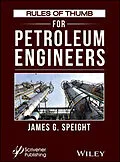The most comprehensive and thorough reference work available for petroleum engineers of all levels.
Finally, there is a one-stop reference book for the petroleum engineer which offers practical, easy-to-understand responses to complicated technical questions. This is a must-have for any engineer or non-engineer working in the petroleum industry, anyone studying petroleum engineering, or any reference library. Written by one of the most well-known and prolific petroleum engineering writers who has ever lived, this modern classic is sure to become a staple of any engineer's library and a handy reference in the field.
Whether open on your desk, on the hood of your truck at the well, or on an offshore platform, this is the only book available that covers the petroleum engineer's rules of thumb that have been compiled over decades. Some of these "rules," until now, have been "unspoken but everyone knows," while others are meant to help guide the engineer through some of the more recent breakthroughs in the industry's technology, such as hydraulic fracturing and enhanced oil recovery.
The book covers every aspect of crude oil, natural gas, refining, recovery, and any other area of petroleum engineering that is useful for the engineer to know or to be able to refer to, offering practical solutions to everyday engineering problems and a comprehensive reference work that will stand the test of time and provide aid to its readers. If there is only one reference work you buy in petroleum engineering, this is it.
Autorentext
James G. Speight, PhD, has more than forty-five years of experience in energy, environmental science, and ethics. He is the author of more than 65 books in petroleum science, petroleum engineering, biomass and biofuels, and environmental sciences. Although he has always worked in private industry which focused on contract-based work, Dr. Speight has served as Adjunct Professor in the Department of Chemical and Fuels Engineering at the University of Utah and in the Departments of Chemistry and Chemical and Petroleum Engineering at the University of Wyoming. In addition, he was a Visiting Professor in the College of Science, University of Mosul, Iraq and has also been a Visiting Professor in Chemical Engineering at the University of Missouri-Columbia, the Technical University of Denmark, and the University of Trinidad and Tobago.
Inhalt
Preface xv
About the Author xxi
Abrasion 1
Absorption 3
Acid Gas Removal 5
Acid Gas Scrubbing 9
Acid Number 11
Acid Rain 13
Acid-Base Catalysts 15
Acidity and Alkalinity 17
Acidizing 19
Adsorption 21
Adsorption Isotherm 23
Adulteration 25
Air Emissions 27
Alcohol Blended Fuels 29
Alcohols 31
Alicyclic Hydrocarbons 33
Aliphatic Hydrocarbons 35
Alloys Composition 37
Amine Absorber 39
Amine Condenser 41
Amine Washing 43
Ammonia 45
Aniline Point 47
Anticline 49
Antoine Equation 51
API Gravity 53
Aromatic Hydrocarbons 59
Asphalt Manufacture 61
Asphaltene Constituents 63
Associated Natural Gas 65
Atmospheric Equivalent Boiling Point 67
Auto-ignition Temperature 69
Barrel 71
Baumé Gravity 73
Benchmark Crude Oil 75
Bernoulli's Principle 77
Biomass and Biofuels 79
Bitumen 83
Bituminous Rock and Bituminous Sand 85
Black Acids 87
Black Oil 89
Blending and Mixing 91
Boiling Point and Boiling Range 95
Brine 97
Bubble Point and Bubble Point Pressure 99
Bureau of Mines Correlation Index 101
Calorific Value 103
Capillary Forces 105
Capillary Number 107
Capillary Pressure 109
Carbon Monoxide and Carbon Dioxide 111
Carbon Number and Possible Isomers 113
Carbonate Reservoir 115
Carbonate Washing and Water Washing 117
Catalyst Pore Diameter 119
Catalytic Materials 121
Catalytic Reforming 123
Cementation Value 125
Cetane Index 127
Characterization Factor 129
Chemical Reaction Rates 131
Chemicals Reactive with Water 133
Chemometrics 135
Clausius Equation and Clausius-Clapeyron Equation 137
Coal General Properties 139
Coke Yield from Conradson Carbon 141
Common Acronyms 143
Common Names of Selected Chemical Compounds 145
Common Unit Conversions 147
Commonly Used Constants 149
Compressibility 151
Coning 153
Conversion Charts 155
Conversion Factors 157
Correlation Index 163
Corrosion 165
Corrosion Fuel Ash 167
Corrosion Naphthenic Acid 169
Cricondenbar 171
Cricondentherm 173
Critical Properties 175
Critical Temperatures of Gases 177
Crude Oil Assay 179
Crude Oil Classification 181
Crude Oil Desalting 183
Crude Oil Distillation 185
Crude Oil Fractional Composition 187
Crude Oil Hydrotreating 189
Crude Oil Molecular Composition 191
Crude Oil Primary Recovery 193
Crude Oil Recovery 195
Crude Oil Refining 197
Crude Oil Residua 201
Crude Oil Sampling and Analysis 203
Crude Oil Secondary Recovery 205
Crude Oil Tertiary Recovery 207
Crude Oil from Tight Formations 209
Darcy and Non-Darcy Flow in Porous Media 211
Darcy's Law 213
Decimal Multipliers for SI Prefixes 215
Decline Curve Evaluation 217
Delivery Point 219
Density, Specific Gravity, and API Gravity 221
Density-Boiling Point Constant 223
Determining Depreciation 225
Dew Point Temperature and Pressure 227
Dielectric Constant 229
Dielectric Loss and Power Factor 231
Diesel Index 233
Dipole Moment 235
Distillation 237
Distillation ...
